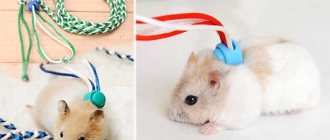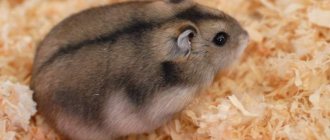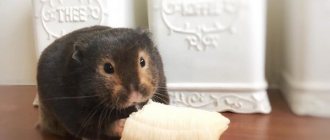- home
- Care
13.04.2018
Experienced hamster owners and breeders are sure that the animal definitely needs walks in the fresh air. The issue gains relevance in the summer and spring periods. There are several options for walking your pet on the street, and the most popular is walking using a special leash.
What are there
The main models are:
- harness;
- harness-vest;
- leash with collar;
- walking ball.
A regular harness is shaped like a figure eight, fastened in the middle with a leather pad to which the leash is attached. One figure eight ring is threaded under the pet’s tummy, and the other is fixed in front of the front paws, covering the neck.
If such a harness is larger or smaller than the pet, then it will be uncomfortable for him to breathe, or the hamster will fall out of it, so the harness mount is movable so that it can be adjusted to the size of the pet.
The size of the harness is checked with your little finger: if you can put a finger between the fastening and the back, then this is the optimal size for the hamster.
The harness-vest resembles a vest with a leash attached at the top. The model is comfortable, does not interfere with movement, and the animal will not fall out.
A leash with a collar is worn in the same way as for other animals. This leash is only suitable for large breed hamsters. This is the least convenient model. Safety measures are especially important in it: prevent it from falling out of the collar, do not make sudden jerks, etc.
A walking ball is a ball made of polymers or plastic with breathing holes and a side lid. Having placed the hamster in the ball, you just need to close the lid and let it onto the floor or onto the platform.
This way the animal will be safe from contact with cats or dogs, and nothing will interfere with its movements. A ball is a better option for training muscles and providing physical activity than a wheel in a cage.
Accessories for walking
There are many accessories that are used when walking. In specialized stores you can purchase:
- leash with collar;
- harness (made of loops or in the form of a vest);
- walking ball.
In a walking ball, the hamster will be able to safely move around the entire territory.
For street walks, you will have to choose between a harness or a regular leash with a collar.
Vests, which are available in different colors, a large number of models from various materials, are especially popular. It protects the animal from dirt and precipitation, securely fixing its body.
How to properly put a leash on a hamster
To put a standard harness on a hamster, you need to:
- take the leash in your hand so as to simultaneously hold both rings in the same plane;
- put the larger ring under the belly, the smaller one under the neck;
- on the larger ring it is possible to adjust its width so as to conveniently fix it on the hamster;
- check the fasteners and tighten them if necessary.
How to put a leash on a hamster: video
To put on a sewn leash vest you need:
- attach the vest to the back;
- fasten both fastenings - on the stomach and on the neck;
- insert the leash into the fastening ring.
You can choose any form of pet walking. But you can’t leave him motionless in a cage, because this negatively affects his health and provokes obesity and other pathologies.
You also don’t have to walk your hamster outside to avoid contact with infections, worms and skin parasites, but anyone can create conditions for him to walk around the house.
Taming Recommendations
When taming a Djungarian hamster, you should remember important nuances:
- Immediately provide the hamster with a “home” where there will be enough space for physical activity . Being energetic animals, dwarfs do not like crowded conditions. In such conditions, they feel oppressed, and the adaptation process can be significantly delayed.
- Place the cage with the pet where there is no constant noise and movement of the inhabitants of the house . Being in a calm environment, the rodent will much faster make contact with the one it considers its owner.
- Avoid the presence of strong aromas near the animal . Any pronounced odors can cause stress.
- At every interaction, please the hamster with his favorite treats . This helps to establish trusting relationships. Regularly receiving small “bonuses”, the pet will become much more willing to fulfill the owner’s requirements.
- Show maximum delicacy . The miniature animal is quite shy. Excessively loud speech, psychological pressure, verbal or other punishments are categorically unacceptable.
- If there are small children in the house, you need to tell them in detail about the rules for handling a hamster . The rodent should not be perceived as a toy, but rather as a new “member” of the family, in need of sincere care, respect and love.
The Djungarian hamster is a popular pet that is easy to keep at home. Being smart, he gradually gets used to the new environment and regular communication with people. By adhering to certain rules, you will be able to quickly tame the Djungarian hamster and make him a true friend and favorite of the whole family. To do this, it is enough to have a real desire, a supply of patience and a little free time.
Types of leashes
Pet stores offer a wide selection:
This type of collar specifically for hamsters is used infrequently, only if the pet is a large breed. Usually it is worn as a decoration, since walking with such a collar is problematic, because the pet can slip out of it at any moment.
This type of collar is more reliable and is best suited for walking. A loop made of leather or fabric material secures the body and legs and is attached to the back. This design will definitely not allow the animal to wriggle out. The harness is put on loosely, so that you can stick your finger into the gap between the loop and the hamster’s body. The collar should not be worn tightly or loosely, otherwise the hamster can be injured or create conditions for escape.
A vest harness is much safer and more reliable. It is believed that the hamster is more comfortable in it. Please note that the harness and collar must be securely fastened, otherwise the hamster may be lost somewhere.
Another worthy option for walking your pet. The walking ball is not a leash, but at the same time it is quite comfortable to use. The material of the device is usually plastic, the ball is dotted with special holes. This option is best suited for walking dzhungarikas or other small breeds, so the hamster will definitely not run away. Larger breeds of rodents will feel uncomfortable, so their use does not make sense.
Benefits of walking
Veterinarians are divided on the issue of walking so many small animals. Some people think this is a bad idea, citing the high likelihood of the pig suffering psychological and psychological damage. Others counter with the factor of the benefits of fresh air for domestic rodents. Recently, popularity has shifted to supporters of active walks with guinea pigs - but with reservations.
Walking your pet in the average yard may not be a good idea. There is so much noise and traffic around that the pig can get psychological trauma. There is an even greater danger from other animals - street cats and dogs, who see such easy prey. They can do something irreparable. Therefore, you can only walk in quiet and peaceful places where danger is minimized.
At the same time, walks in the fresh air, the opportunity to run on the grass and chew on twigs to the fullest are very useful for guinea pigs. They may be domestic animals, but they are active and inquisitive animals. Their mood noticeably improves, which gives the owner positive emotions.
The benefits of walking a guinea pig include the following:
- These furry creatures are prone to obesity, despite their miniature size. Walking does not threaten them with this disease.
- Pigs are social animals; being confined to their own home can, oddly enough, depress them. Introducing such variety will help avoid stress in your mumps and its unpleasant consequences.
- A harness for a guinea pig is necessary - a guarantee that the animal will not disappear without a trace under the nearest bush.
How to make a harness with your own hands
If the pet store does not have accessories of this type or you could not find a suitable one, then you can easily make it yourself. No special pattern is needed. All you need to do is carefully examine the harness in the photo and accurately measure your pet. Taking all this into account, sewing a collar yourself will not be difficult.
A few tips you might find useful:
- Organize a strong and reliable fastening.
- The material should be thick or leather.
- The harness should be bright, for greater practicality.
- The size should not be large or small.
A homemade harness is different from a store-bought one; it is much more convenient, because it is tailored individually to your animal.
After the harness, all that remains is to pick up the leash. Any strong rope to which you need to attach a carabiner is suitable for this.
Necessary materials
The simplest variety to make yourself is a figure eight shaped harness. In order to make it, you only need one rope. It should be long enough, so it should be used for the area around the neck and body. Therefore, its length should be at least 20cm. Any material will do
However, it is important to avoid rough abrasive ropes, which can irritate the rat's skin.
- A collar that fits the rat's neck.
- One that will hug her chest just behind her front paws.
- A long collar that will be used as a connecting element.
To create a vest harness you will need high-quality elastic fabric and a metal ring. You can use special fabric for animals, but regular fleece or cotton fabric will do just fine.
DIY hamster harness
If you want to walk your hamster, you should understand that this is a very active and fast animal, which, having escaped, can run into a secluded corner and you will no longer find it. To prevent this situation, it is necessary to use special walking accessories. You can easily find walking harnesses in pet stores, but you can make this accessory with your own hands.
Main varieties
There are 3 main types of harnesses. However, you can buy a collar, but it can put pressure on the rat’s neck. Therefore, you should choose from the following types of accessories:
- Figure 8 Harness - This type of harness has two loops, one going behind the front legs and the other going around the neck. The device is attached at the junction of two loops at the withers (the base of the neck above the shoulders).
- H-shaped harness – This accessory has two loops, like a figure eight. But the loops are not connected directly; they are connected by a separate piece of material, such as a nylon strap.
- A harness vest is a fitted fabric vest that fastens around the neck and belly with Velcro, buttons or zippers and has a ring at the back for attaching a leash.
If you don't want to buy a harness, you can make your own.
How to make a leash for a hamster
You don’t need any special pattern to make the harness; you can make it yourself. Just look at the photo of this accessory or examine it in a store to understand how it can be made.
It is important to measure the crumb correctly. The following measurements will be required:
- The circumference of your pet's neck.
- Abdominal girth.
- Along the ridge, you need to measure the distance from the neck to the lumbar region.
You will need the following materials:
- Needle and spool of strong thread.
- Metal rings, 0.5 cm in diameter.
- The carabiner is small in size, it can be either metal or plastic.
- Cord or strong tape.
You will also need paper, pencil, ruler and scissors.
Necessary materials
Today, pet stores offer a wide range of models of harnesses for rodents.
They are practical, functional, made from various high-quality materials, but their main disadvantage is their high cost. For this reason, many breeders prefer to make their own leash. Before you start creating a product, you should understand what types there are:
- From straps. These harnesses have a simple design and can be adjusted to fit the size of your pet. The straps under the rat's limbs encircle its torso and neck, and along the line of the belly and back there are straps that connect the entire product. To make such a leash, scraps of genuine leather and braided cords are usually used. Both latches and buckles are suitable as locks.
- Velcro. This design is mainly made in the form of a vest with fasteners located under the chest. A ring is attached at the bottom of the backrest, designed to secure the harness. Basically, leashes are made of durable, elastic nylon, which is conveniently and securely fixed to the rodent, preventing it from freeing itself and running away.
For home production, the first option is considered the simplest option. During the sewing process, materials such as thick cord made of dense fabric or strips of durable fabric can be used. You can make a product from leatherette or genuine leather, but in this case you will need special tools to work with this type of material.
Did you know? According to scientists, there are twice as many rats on planet Earth as there are people.
As fasteners, it is allowed to use small metal buckles or plastic fasteners, which are sold in any sewing store. You can use small buttons or buttons, but putting this harness on your pet will be extremely inconvenient and difficult. Of course, in the process of sewing a product you will need a pattern.
The simplest version of the pattern is shown in the photo below:
Where:
- a: 0.5–1 cm;
- c: width of the rat’s body behind the forelimbs;
- c: required interval between ring b and d;
- d: rodent neck volume;
- g, h: latches, for example, Velcro, which are sewn on both sides of the harness;
- e: a clasp, which can be used as a paper clip, or a carabiner from a mobile phone.
If you want to develop a pattern yourself, it is recommended to take the following measurements from your pet:
- neck girth;
- girth of the body behind the forelimbs;
- the interval between the two previous marks.
Popular models
Let's look at hamster leashes and harnesses that are popular with pet owners. The following models have proven themselves well:
- Gamma. A simple harness made of cord with a diameter of 6 mm, leash length 1.3 m. For large hamsters. Metal carabiner and sliders. Price – from 100 rubles.
- Ferplast. Open harness made of nylon cord. The size is easily adjustable, so the accessory is suitable for dwarf hamsters and large Syrians. Cost – from 220 rubles.
- Ferplast jogging small. A vest for small rabbits, which is also suitable for a well-fed hamster. The size is adjustable, all fastenings are made of plastic. Costs 690 rubles.
- Taonmeisu. Open harness for jungarik with a bell. The harness itself is made of nylon, the fastenings are metal. Price from 170 rubles.
Not everyone has the opportunity to purchase such things for their tiny pet. If you want to dress up or walk your pet, you will have to make an accessory for your hamster with your own hands.











